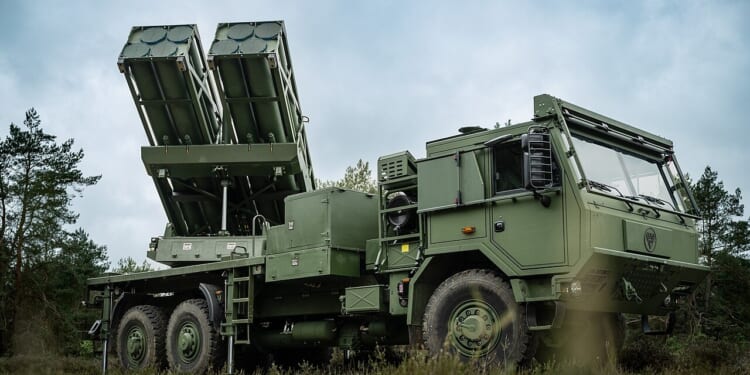The Israeli-made PULS offers several operational advantages that distinguish it from competitors like the U.S.-made High Mobility Artillery Rocket System (HIMARS) or older Soviet-era systems.
After enduring seemingly endless provocations from fellow NATO member—but regular antagonist—Turkey, the Greek military has purchased 38 PULS missile systems produced by Israeli firm Elbit.
These systems, according to the Greek military, will be deployed to strategic Aegean islands that are capable of striking deep into Turkish territory, from Izmir to Istanbul. This continues the back-and-forth that has defined the last decade of Greco-Turkish relations and does not appear to be abating, even as NATO publicly downplays concerns about disunity within its ranks. And, given that both Greece and Turkey are members of NATO—raising the question of which side NATO is obliged to intervene on if an armed conflict breaks out between the two— Athens cannot be certain that Brussels will even have their backs. So Athens is taking matters into its own hands to serve up its own semblance of deterrence.
All About Israel’s PULS System
The Precise and Universal Launching System (PULS) embodies the qualities needed for modern warfare: precision, adaptability, and cost-effectiveness. Since its introduction, the PULS system has garnered international attention for its versatility, advanced technology, and operational efficiency.
Elbit Systems, the firm that produces the PULS system, was founded in 1966 and is headquartered in Haifa, Israel. It is a leading global defense technology firm renowned for its innovative solutions across air, land, sea, and cyber domains. Indeed, its acquisition of Israel Military Industries (IMI) in 2018 bolstered Elbit’s expertise in rocket artillery, paving the way for the development of PULS as an advanced iteration of the earlier Lynx system.
PULS was introduced into the Israel Defense Forces (IDF) in 2020 under the name of “Lahav.” The vehicle-mounted missile system was designed to meet the demands of modern battlefields, where rapid response, precision, and interoperability are critical. Its design reflects Israel’s strategic emphasis on technological superiority, driven by the need to counter diverse threats in a volatile region.
By integrating cutting-edge guidance systems, modular design, and compatibility with existing military vehicles, Elbit created a system that balances firepower with operational efficiency. The result is a multiple launch rocket system (MLRS) that delivers precision strikes with minimal logistical overhead, aligning with the needs of both advanced and resource-constrained militaries.
The PULS system is distinguished by its ability to launch a wide range of munitions, from unguided rockets to precision-guided munitions, with ranges spanning seven to as far as 186 miles. Its multi-purpose launcher features two interchangeable pods, each tailored to specific rocket types; the Accular 122mm (18 rockets, 21-mile range), the Accular 160mm (10 rockets, 25-mile range), the EXTRA (four rockets, 93-mile range), and the Predator Hawk (two rockets, 186 mile-range). Moreover, PULS can deploy advanced munitions like the SkyStriker loitering munition—better known as a suicide drone. This versatility allows a single platform to engage diverse targets, from frontline positions to high-value assets deep behind enemy lines.
The system’s autonomy and precision are driven by advanced fire control and navigational systems. These give it rapid mission execution—typically in under one minute—and accuracy within 32 feet Circular Error Probable (CEP) for long-range strikes.
And unlike conventional artillery, PULS does not require repositioning to adjust firing range, as it can launch varied munitions from a fixed position. Its compatibility with wheeled and tracked platforms, such as the Heavy Expanded Mobility Tactical Truck (HEMTT) truck used by the IDF or the Tatra T815 for Denmark’s army, reduces maintenance and training costs by leveraging existing logistics.
Why Greece Needs the PULS System Against Turkey
PULS offers several operational advantages that distinguish it from competitors like the U.S.-made High Mobility Artillery Rocket System (HIMARS) or older Soviet-era systems.
First, its modular design allows for greater firepower and flexibility. For instance, PULS can carry 300mm rockets compared to HIMARS’ six 227mm rockets, or four tactical missiles versus HIMARS’ one.
Second, its rapid reload capability ensures operational readiness, critical during intense combat. The reload capacity allows for new pods to be fitted in under ten minutes. And finally, the system’s precision reduces collateral damage, making it suitable for urban warfare and operations requiring surgical strikes.
Greece will need the PULS system if it is to have any chance at deterring Turkey’s increasing belligerence in the Aegean Sea or near Cyprus. The animosity between Turkey and Greece goes back to antiquity, and the fact that both nations ended up on the same side of the Cold War has done little to keep their two forces from swatting at each other. Greece is taking necessary defensive action to deter Turkey from future aggression, which could come at any moment.
About the Author: Brandon J. Weichert
Brandon J. Weichert, a Senior National Security Editor at The National Interest as well as a contributor at Popular Mechanics, who consults regularly with various government institutions and private organizations on geopolitical issues. Weichert’s writings have appeared in multiple publications, including the Washington Times, National Review, The American Spectator, MSN, the Asia Times, and countless others. His books include Winning Space: How America Remains a Superpower, Biohacked: China’s Race to Control Life, and The Shadow War: Iran’s Quest for Supremacy. His newest book, A Disaster of Our Own Making: How the West Lost Ukraine is available for purchase wherever books are sold. He can be followed via Twitter @WeTheBrandon.
Image: Wikimedia Commons.

















